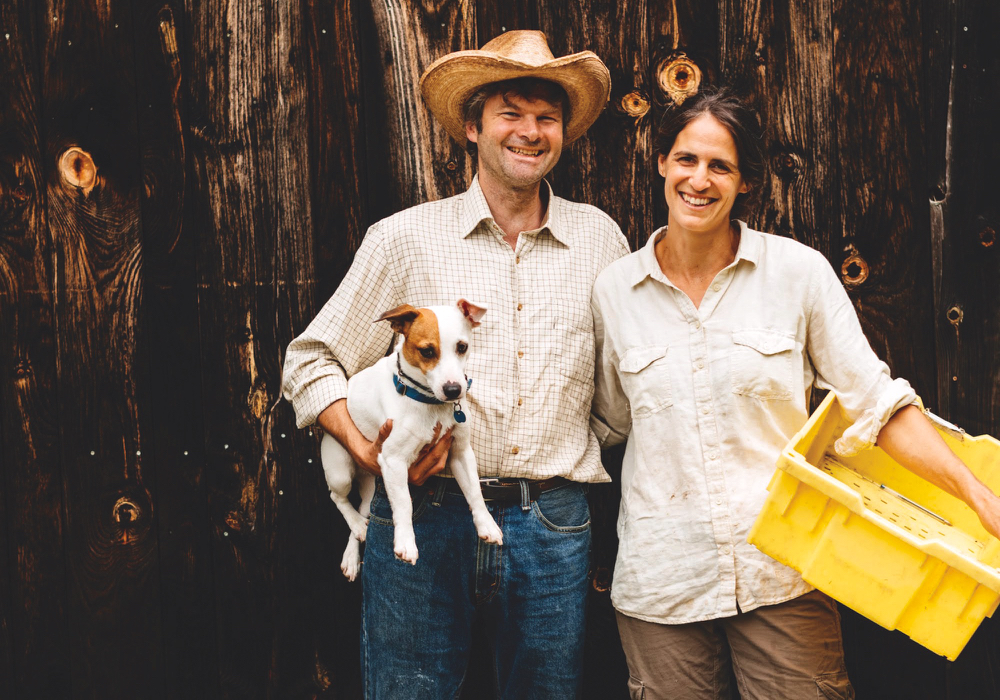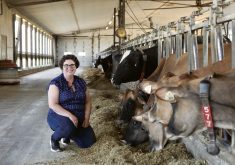About 10 years ago, New Hampshire farmer Dorn Cox was thinking how agriculture will need new ways of tackling such huge challenges as climate change, biodiversity loss and depleted agricultural soils.
In the past, the collaborative approach had always saved agriculture. Farmers have pooled their ideas, shared their results and found big solutions much faster than anyone could find them on their own.
But how could the old ways work with today’s new threats?
As Cox looked harder at that word “collaborative,” he began to think maybe it’s still the right strategy, if only it could be brought up to technological date. Maybe collaborative, he thought, should actually be “open source.”
Read Also

Riding the tariff rollercoaster
Farmers are accustomed to roller-coaster years. But the current geopolitical windstorm is something else entirely. On his cattle operation near…
Now his work is beginning to look like the start of a hugely innovative change in farming.
“We’re asking a lot more of agriculture now, not just to produce food, but also in land management, and mitigation and adaptation to climate change, as well as habitat for biodiversity,” says Cox. “Agriculture hasn’t always been fully recognized in terms of these roles.”
Cox and his family still operate the 250-acre, certified organic farm where he grew up in Lee, New Hampshire. Tuckaway Farm’s production is highly diversified, integrating livestock and timber enterprises with over 100 different types of crops including fruits, vegetables, grains, oilseeds and hay. The family operates a Community Supported Agriculture (CSA) program and sells their produce direct at local markets, restaurants and valued-added businesses.
A systems approach to the farm
Cox took his farm experience to the University of New Hampshire, earning a PhD in natural resources and earth systems science by focusing on collaborative, open source agricultural research development.
He began to develop the concept of open source farming, and was looking for some way to demonstrate the value of the OpenTEAM digital tools and platforms he was working on.
That’s what led him to join the Research Advisory Committee at the Wolfe’s Neck Center for Agriculture and Environment in Freeport, Maine, where he later became research director.
“All of these systems need to be translated into action on the ground, and Wolfe’s Neck Center was a great test platform because we had the capacity to do research as a non-profit farm,” Cox says. “More importantly, unlike the university, its mission was to create intersections between the general public researchers and producers, and to move agricultural science forward.”

It may not exactly be conventional agriculture, but Wolfe’s Neck Center had some real strengths. It was focused on education, hosting about 30,000 visitors a year with educational programs and even summer camps for kids, and it was looking for a way to build a research farm that could somehow bundle and distribute agricultural research from around the world for use on all sorts of mainly organic and regenerative farms.
It was an opportunity that finally morphed into OpenTEAM, a collaborative research project launched last July that aims to create the digital tools and platforms to provide everyone, everywhere with access to the best agricultural knowledge about improving soil health and mitigating climate change using regenerative practices and technologies.
From there, the technology could form a model that would be used to support almost every kind of agriculture, almost everywhere.
The birth of OpenTEAM
OpenTEAM has over a dozen partners, including Stonyfield Organic, the Foundation for Food and Agricultural Research (FFAR) and the USDA, and brings together farmers, universities, food companies and cutting-edge technologists to create easier farm access to existing tools, and to develop new tools for improving soil health. It creates an open source digital platform to share knowledge and innovation that is designed to help a growing network of farmers around the world make better decisions about how to improve soil health.
The development of open science and open source technology is a reflection of the increasing awareness that agriculture is a large-scale system encompassing everything from the microbiome to the biosphere and biogeochemistry.
“In order to get at, and understand, and ask the next round of questions, it’s necessary to transition how we do agricultural science and who’s involved,” says Cox. “There’s a new conception of agriculture as a shared human endeavour, and this public science is a system science, which means that we have to collaborate.
“It can’t be done in laboratories or even on isolated research farms if we’re going to achieve what we need to achieve.”
The three components
There are three main components of OpenTEAM. The first is the technical ecosystem, consisting of all the tools and communities associated with the tools.
The second is the farm network, which is where it’s actually put into practice and translated into local production systems at different scales, from a small holding in Africa to a large-scale grain operation in Canada.
The third part connects the two other components. “We have a team which is essentially adapting the tools and technologies led by the users who are going to actually implement it in the field,” says Cox.
When visualizing open source farming, it’s important to begin by seeing it as an ecosystem, not a single technology, and that its tools and functional communities work together to create something greater.
The tools themselves are observation and decision tools. Observation tools are things like the Quick Carbon application, farmOS, and the Our.Sci application. These are all tools for gathering high-quality observations of soil, land cover and agricultural management practices.
FarmOS is a free, open source farm-management and record-keeping tool that can also connect to other farm management record-keeping systems, and it can also connect them beyond that to other tools.
Cox’s concept for farmOS was motivated in part by his desire for a system that would help him manage the complexity of his own diverse farm, which has become a research laboratory for many of the open source farming ideas he has come up with over the past decade.

FarmOS enables the aggregation of huge amounts of data collected from individual farms, universities, research institutions, government agencies and the entire global food system and connects it together to make the information both secure and controlled by the farmer, and shareable and easily accessible to anyone who loads the free software to their computer or mobile device.
“What we aim to do with farmOS is understand a farm at its most fundamental,” says Cox. Sensors on the farm measure soil and other environmental indicators like temperature, humidity or soil moisture and relay it back to the farmOS platform, where it can be accessed and also overlaid with other data, such as USDA soil survey maps. “The intention is to be able to have democratised access to environmental data so that everybody has access to high-quality, high-resolution data that will help them understand soil health and aim to improve soil management techniques in the future, at very low cost.”
LandPKS is a land cover and soil mapping app that’s especially useful in areas that don’t have good soil maps. “It allows you to generate a very high-quality map, with rigorously peer-reviewed methodologies, but in a very simple and inexpensive way,” says Cox.
The Quick Carbon app adapts to any in-field methodology to digitize and share that methodology and reproduce it regularly, so that results can be compared. It also connects to hand-held, in-field measurement devices like a spectrometer that will do in-field soil carbon assessments and soil colour evaluations. “It’s basically laying the ground work for new low-cost digital tools in the field,” says Cox.
Making open source tools accessible for everyone is a big focus for the OpenTEAM project, and at Wolfe’s Neck Center, Cox and his collaborators are using low-cost sensor and data loggers alongside high-end, industry-standard equipment to compare results and try to develop the best, low-cost tools for farmers to use in their own fields.
The farmer or crop advisor collects and inputs data from the field, which is then assessed with huge, up-to-the-minute archives of research and farm experience.
The power of open source
The potential for open source farming goes far beyond the individual on-farm level. Its real power will come in aggregating field-level and site data with other participants to feed more quality data into remote sensing tools like satellite imagery.
What’s important about the design of recent generation open source tools and technologies is that they can be inter-operable, and they’re a part of a larger system, says Cox.
“When people are doing research or developing tools to do research or developing products, they’re doing it with the knowledge and intention that it will be used and re-used by others,” says Cox. “It’s a different cultural approach.”
Open source is also not to be confused with open data, says Cox.
“There are certain types of data that we’re already investing in that are part of the public knowledge commons,” he says. “Those are the things that are the basis for our understanding in science, so that’s things like climate data, soil data, weather data and the way in which we describe our understanding of the plants in the world, what grows well where.”
Open source tools involve making the software blueprints available so others can figure out how to work with them and continually improve them to interpret open data.
Farmers control the data
The underlying concept of open source farming tools is that farmers can control their own data but also have the option to share it. Data entered into the OpenTEAM tools like farmOS can be used by anyone the producer chooses to share it with, such as researchers or certifying bodies.
“If they choose to share their data, they can have confidence how it’s going to be used and that’s really important because often ‘open’ means a free-for-all and everything is free, and that’s not the case with OpenTEAM,” Cox says. “It’s a different approach, but we think it’s a better approach.”
There is additional value if producers need to obtain environmental, organic or other certifications, because they can use the data for things like food safety programs or supply chain verifications.
“That’s all data,” says Cox.
A collaborative system like open source farming creates multiple points of connection that increase the confidence in outcomes, says Cox.
“It cannot exist with a single entity owning it, nobody would trust it, so that’s why we have to have this sort of pre-competitive space where we agree on how this system works, so that we can do these other things,” he says. “OpenTEAM is really focused primarily on creating value for the farmer and allowing farmer control.”
Local knowledge applied globally
Looking at other large-scale, collaborative projects (i.e. the internet) that rely on open source servers, Cox feels the OpenTEAM project has almost limitless potential as a global ag information system.
“The underlying collaborative science project is not dissimilar from something like the Human Genome Project,” Cox says, although it’s actually more complex because agriculture is constantly changing.
For Cox personally, it’s encouraging to see the community grow. “We have gone from a concept to essentially launching a functioning community in three years,” says Cox. “This is a human process, something that we can do together. It’s not something that you have a robot go out and do. It doesn’t work to have just a bunch of scientists saying, ‘If you do this, it’s going to work.’ You have to engage people where they are, and who they are, in order to make this transition happen, and this participatory, engaged science is the foundation of it.”
















